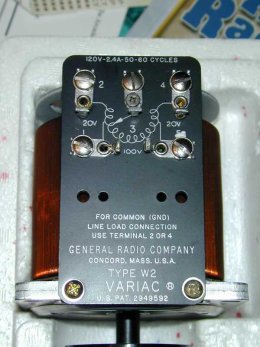Phil Nelson
2005-12-29 19:29:57 UTC
Secret Santa generously sent me a NIB General RadioW2 variac (thanks, man!).
I would like to wire it up with a voltmeter to show output voltage and an
ammeter to show current draw.
The internal connections are shown here:
Loading Image...
I guess terminal 3 is the variable output, and I would put the ammeter in
series with that terminal and the line going to the radio. I suppose the
voltmeter would be wired across that terminal and one of the others.
My feeble brain doesn't quite grasp why there are four other terminals . . .
.
Any help?
Phil Nelson
Phil's Old Radios
http://antiqueradio.org/index.html
to contact me via email, kindly go to http://antiqueradio.org/contact.htm
I would like to wire it up with a voltmeter to show output voltage and an
ammeter to show current draw.
The internal connections are shown here:
Loading Image...
I guess terminal 3 is the variable output, and I would put the ammeter in
series with that terminal and the line going to the radio. I suppose the
voltmeter would be wired across that terminal and one of the others.
My feeble brain doesn't quite grasp why there are four other terminals . . .
.
Any help?
Phil Nelson
Phil's Old Radios
http://antiqueradio.org/index.html
to contact me via email, kindly go to http://antiqueradio.org/contact.htm